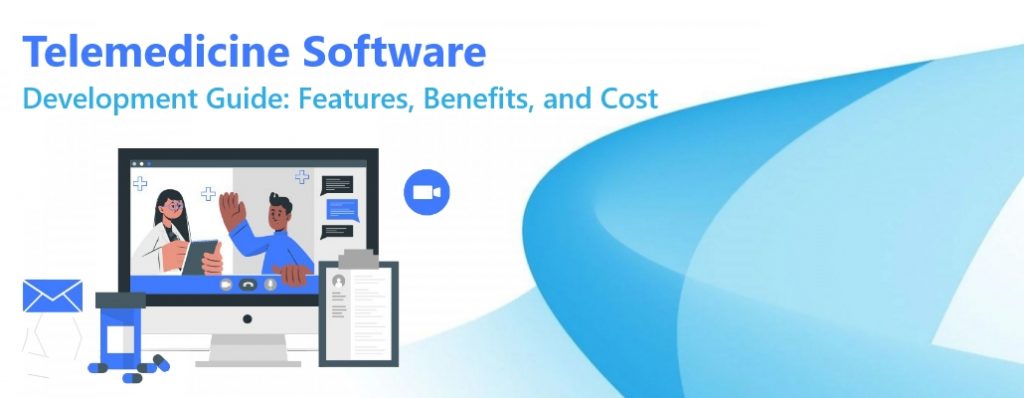The telemedicine industry‘s digital development reflects a shift in the healthcare sector. The present corona virus outbreak has slammed the healthcare service industry’s doors shut. After just one outbreak, our healthcare system released the critical need to improve medicinal healthcare efficiency. Telemedicine software development is gaining traction, market demand is increasing, and the healthcare landscape is changing as a result.
What does Telemedicine software mean?
Patients and doctors can communicate over the internet using Telemedicine Software Development. Patients can use the application’s video calling feature to consult with healthcare specialists. They utilise this software to seek advice on their chronic illnesses. Patients can consult any of the doctors or physicians on the list.
Patients and healthcare providers must first sign up for a telemedicine app. Patients can use the app to search for doctors and schedule appointments with them. People can manage various illnesses such as addiction, blood pressure, cholesterol, and diabetes while sitting at home with a telemedicine smartphone solution. Let’s take a look at how a telemedicine app works point by point for a better understanding.
Also Read – How to Build an Online Doctor Consultation App with your Required Features.
Why Develop a Telemedicine Software?
When it was predicted that consumers would require novel healthcare solutions in the near future, telemedicine software development gained traction. According to Statista, the telemedicine market will be valued $175 billion by 2026.
The concept of telemedicine is now evident to us. What are the advantages of this software for both patients and enterprises, though? Let’s take a look at each of them individually.
- Reduced Healthcare Costs
Businesses don’t need to rent office space when they use remote healthcare services. As a result, more self-employed and experienced doctors will be able to provide their services. They previously worked for a corporation, but the capabilities of telemedicine apps allow them to become self-employed and deliver services on their own.
- Making Healthcare More Accessible
Patients and healthcare providers are no longer separated by physical barriers because of telehealth. The sector is able to make healthcare available to more people at all levels, from the most complex, cutting-edge level, where robotic technology and telepresence are utilised to enable surgery remotely, to something as simple as a breathing exercise app. Even further, electronic healthcare education solutions have the potential to educate people on optimal personal practises. You can opt for web development services.
- Easier Access to Healthcare
According to the NRHA, there is a scarcity of healthcare workers. Telehealth apps can be extremely beneficial to folks who live in remote, rural places. If there are no healthcare facilities nearby, having an app and access to a cellular network or WiFi is sufficient. Furthermore, persons from nations with a low level of healthcare might seek advice from foreign doctors. Get in touch with a top software development company.
- Time-Efficient Treatment
Some doctors work in a traditional hospital, while others may take a day off. A comprehensive health examination could take several weeks and several hours of commute time. Telemedicine, on the other hand, is a different storey. A person’s time spent getting health treatments through telemedicine apps was cut in half. Hire dedicated web developers.
- Better Prevention
Currently, healthcare is almost entirely devoted to the treatment of pre-existing medical disorders. However, there is a lifetime of activity that takes place before a patient’s illness manifests. Telehealth encourages everyone to make better personal health decisions and delivers better preventative tactics than in-person treatment can, thanks to education and remote monitoring.
Must-have Telemedicine Software Features
Audio and Video-enabled Conferencing:
Most Telehealth solutions include interactive Audio and Video Conferencing modules that assist doctors in diagnosing patients based on visual cues. This function was rated as critical in providing remote counselling by 94 percent of survey respondents.
Patient History Management and Analysis:
Advanced Telemedicine systems not only offer a way to contact patients over the internet, but they also keep track of their medical history. This aids the collaborating physician in gaining a better grasp of the case, which is essential for effective therapy. For these reasons, 79 percent of respondents rated patient data analysis as important, while 74% desired direct access to patient information from the platform.
Profile management:
After registering, a user must create their own personal profile. It contains basic personal information such as name, gender, and age. The user’s EHR is the most essential piece of information in a profile. Doctors can use it to check patients’ health problems and review their previous treatment records. Keep in mind that this information is confidential and should only be shared with doctors and the owner.
Secure chats:
The one-to-one messenger is an excellent way for a doctor and a patient to communicate. This is a simple feature to develop and may be included in the first edition of the app. It’s worth noting that a more advanced messenger with a multi-user chat system is more difficult to create; it takes a lot of effort and time, especially in the healthcare industry.
Remote Scheduling and Appointments:
The capacity to organise and schedule appointments becomes crucial in situations where a significant frequency of patient appointments is required. As a result, telemedicine platforms that provide a Physician Scheduling feature will always be given preference. It assists medical staff in successfully managing their tasks and providing timely treatment to patients.
Also Read- Patient Portal Software Development Benefits & Key Features in 2021.
Technologies Used in Telemedicine Software development
The following technologies are useful in the development of telemedicine software:
Artificial Intelligence –Artificial Intelligence (AI) is becoming more prevalent in telemedicine applications. The use of language processing, chatbots, speech recognition, and machine learning in healthcare services creates a unique experience.
Blockchain – In contrast to traditional records, blockchain technology prevents the loss of healthcare data. Medical data can be safely stored and exchanged thanks to blockchain technology. Blockchain technology in the pharmaceutical industry is the latest and most popular trend.
Big Data – In the healthcare industry, a great deal of data is generated and analysed. It is possible to collect and analyse EHRs using big data computations (electronic healthcare records). This information can be utilized to improve therapies, provide more precise diagnoses, perform medical research, and ultimately save money.
mHealth Technology – mHealth is a subset of telehealth applications that focuses on using mobile technology for medical purposes. In a nutshell, mHealth is a collection of mobile phones, telemedicine apps, equipment, and connections that enable users to engage in mobile medicinal practises. This WHO definition of mHealth will crystallise the concept in your mind.
IoT – Tablets, medical kiosks, digital cameras, smartwatches, and other telemedicine devices are examples. Vitals tracking, diagnosis, treatment suggestions, medication adherence, built-in emergency response systems, and more are all aided by the Internet of Things. The telemedicine app development solution uses a combination of medical devices and software to provide improved patient care.
AR/VR Applications – AR/VR apps have paved the way for the expansion of medical services. AR/VR has proven to be useful for both education and training. Convenient and easy health diagnosis is achievable with AR/VR apps and virtual doctor appointments. People can now speak with a medical practitioner as a result of this trend.
Also Read – How Has AI Changed The Pharmaceutical Industry?
What is Telemedicine Software Development Cost?
If you truly want to benefit from a telemedicine software, the expense of developing its telemedicine solution shouldn’t be a concern. Everything is included in the price, including the design, wiring, software development, construction, launch, and maintenance.
What are the costs of developing a telemedicine software? The cost of a software ranges from $20,000 to $100,000, depending on the features incorporated. The cost will be the lowest if constructing a simple-designed.
However, depending on the features, the cost of developing a more complicated software will range from $70,000 to $100,000. For example, if you decide to eliminate the online prescription option from your software, you’ll save $3,000 right now.
Wrapping up –
We’re already familiar with the industry trends and technologies that go into creating a telemedicine software. Now it’s time to figure out which companies and development partners are already dominating the telemedicine market.
ThinkStart Pvt Ltd is a Telemedicine Software Development Company in USA, with years of experience. Our experience and talents enable us to create custom software solutions that improve the efficiency of a wide range of healthcare organisations.





























